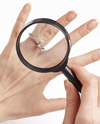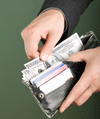Tips for everyone.
"Do it in person and do it in public."
If you follow this mantra, you should be safe. But sometimes a scammer will have a convincing scam up their sleeve, which is why you should also follow these additional precautions.
Be extra cautious of people who make up reasons for why they suddenly can't meet in person and pressure you to decide fast, especially if shipping to a foreign country is involved.
Buyers
- Don't send money to someone you haven't met in person
-
through Western Union or Moneygram
-
through wire transfer
-
through Paypal unless they are a verified Paypal member or they have a positive online reputation (note: contrary to popular belief, Paypal will not reimburse you if you don't receive your item unless you were buying an eligible item directly on eBay -- so don't assume that a Paypal payment makes everything safe)
-
to foreign countries
- Don't fall for fake protection programs.
-
There is no service provided by Oodle, Paypal, or Facebook, that "holds the payment until the item was shipped". There are escrow services out there, but scammers sometimes pretend to be one, so you should research an escrow service and its reputation before using one.
-
eBay does have a Vehicle Protection Program, but only for items purchased directly on eBay.
-
Oodle does not provide a "Bill of Sale" or any other transaction assistance.
-
Read more in our Buyer Guide
Sellers
-
Beware of checks. It takes a few weeks for your bank to notify you that you deposited a fake check. It's best to go to the bank with the buyer and get a cashier's check issued in person.
-
Never accept extra payment with complicated excuses.
-
Never send a portion of the money back to the buyer, a shipping agent, or any other person.
-
Read more in our Seller Guide
Job Seekers
-
Don't accept checks sent to you for purposes other than salary.
-
Don't trust any scheme where you have to send money to someone, or buy goods from some specific place.
Renters
-
Never send or accept any payment before seeing the place and meeting the landlord.
Email communication
As a new tool to protect the users of site on the Oodle network, including Marketplace on Facebook, Oodle implemented a proprietary email anonymization service. Whenever an interested user starts a conversation with someone who posted an ad on our network, both of them are assigned an anonymized email address that looks something like this: 123456b123456@anon.oodle.com. Doing this provides an additional layer of protection from fraud.
Here are some frequently asked questions about this system:
Why do I see things like [email blocked] or XXX@XXX.com in my emails?
Scammers often try to get around our safety system by asking you to contact them directly. If they put their address in the message, we will try to hide it.
What do I do if the other person insists that I contact them directly at their personal email address?
They might be a scammer. Usually, there should be no reason for you to have to contact them directly.
What do I do if I really need to give the other person my personal email address?
There are some rare cases where you might legitimately need to give the other person your email address. We recommend that you give them your address through the phone or after you met them in person.
How do I report a suspicious message?
If you think the other person is doing something suspicious, you can forward their email to fraud@anon.oodle.com and our automated tools will analyze the message.
Buyer guide.
- Initial Contact
Ask questions.
When you first contact a seller by phone or email, express your interest in the item and ask any questions you may have. Ask about the condition and/or history of the item. Ask to see digital photos as well.
Limit personal information.
Limit the amount of information you share about yourself (for example, don't give out your home phone or address and remove personal information from your email sig file). However, after the seller has answered some questions and seems credible, you may need to disclose more information about yourself such as your name and cell phone number (but keep it limited to that).
Establish the credibility of the seller.
In addition to communicating over email, we recommend talking to the seller by phone before meeting them.
If the seller seems evasive or suspicious, or makes you uncomfortable at any point during the initial contact process, do not continue to pursue the transaction.
- Meeting the Seller
Meet in a public place.
Meet in a public place if possible - during the daytime when other people will be around.
Bring a friend.
If the item is large, like a piece of furniture, and you must go to the seller's home, always let someone know where you are going. You may also want to share whatever contact info you have for the seller (their email address, phone number).
If the seller seems evasive or suspicious, or makes you uncomfortable at any point during the meeting, simply excuse yourself.
- Seeing and Evaluating the Item
Do your research.
It always helps to do advance research on the market value of item so you will know if you are getting a good deal. You may want to bring copies of similar listings with you that support your valuation. Don't be afraid to haggle or negotiate on price, but don't insult the seller with an unreasonably low offer.
See it before you buy it.
Always see the item in person before you buy it. If it is merchandise, inspect its condition carefully. If it is a car, check the vehicle history (carfax.com offers a vehicle history for about $30) and ask for receipts for any service records. You can also request a pre-purchase inspection at a local mechanic, (generally between $100 and $300), a service which can identify potential safety and mechanical issues. Take the car on a test drive and for extra precaution, ensure that the car is registered in the seller's name. If the item in question is a pet, check its veterinary records and pedigree papers.
If the item is not as described or pictured, don't be afraid to walk away from the deal or change your offer.
- The Transaction
Pay cash.
In online classifieds, it's best to pay cash and to keep the payment simple. Do not use personal checks, money wires, Western Union or Moneygrams. Do not give out any personally identifiable information such as bank numbers or credit card numbers.
For big purchases, use cashier's checks.
For an item priced over $1,000, you may be more comfortable using a cashier's check from a well-known bank so you don't have to carry around the cash. You can bring a cashier's check in person to your first meeting, but it may be better to wait until you are sure you want to buy the item since you will need to make it out to the seller and you will need a final amount. You should also ask for a signed receipt.
Protect your personally identifiable information.
Don't give out your social security number, bank numbers, credit card numbers, etc. If someone like a landlord asks for your social security number, give them a copy of your credit report instead, with your social security number blacked out.
If the seller seems evasive or suspicious, or makes you uncomfortable at any point during the transaction, walk away from the deal. Always trust your instincts.
Seller guide.
- Posting Your Ad
Be descriptive, use photos.
Describe your item as accurately as possible so potential buyers don't become irritated if the item is not as expected. Include photos to give an idea of the appearance and condition of the item.
Limit personal information.
When posting your classified ad, use an email address that does not personally identify you (for example use a Gmail, Hotmail or Yahoo email rather than a work or home email). If you use a phone number, use your cell number instead of your home phone.
Be direct and respond to potential buyers, answering questions and also finding out any information that may help inform the person to whom you are selling or renting.
- Responding to Initial Contact
Answer questions.
Respond to any interested buyer over email and/or by phone to answer his or her questions and to determine whether he or she is someone with whom you want to do business. Try to get a sense of his or her overall credibility and trustworthiness to see if you want to move forward.
Limit personal information.
Don't disclose any personally identifiable information, like where you work, until you feel comfortable with the other person. Avoid inviting someone to your home.
If a buyer seems to act suspicious or raises any red flags during preliminary contact, trust your instincts and walk away from the deal.
- Meeting the Buyer
Avoid doing business with people who are not local.
Classifieds transactions should always be done locally. Don't accept offers from potential buyers you can't meet in person, especially those over your asking price. A common scam is an offer over your asking price plus an extra amount for shipping. The "buyer" will send a counterfeit cashier's check and ask you to refund the difference back to them. By the time you discover the cashier's check is counterfeit, it's too late.
Meet in a public place; avoid being alone.
Meet in a public place if possible, or if the item is large, like a piano or a washer and dryer, arrange to have a friend over when the buyer arrives. If you are selling an item, you may want to schedule your showings all at one time, especially if you are at home alone (there is safety in crowds). Let a neighbor know that potential buyers are coming to your house.
Be prepared to negotiate.
A buyer may want to haggle with you about the price of an item. Be prepared to negotiate the price and terms of the transaction, but be clear where you stand.
Remove listing when sold.
For common courtesy and to avoid angering potential buyers, once your item is sold, be sure to remove your classified ad and contact any interested buyers so they don't waste their time coming to see it.
If a buyer seems evasive or suspicious, or makes you uncomfortable at any point during the meeting, walk away (or ask them to leave if they are at your house).
- The Transaction
Insist on cash. In online classifieds, cash is the safest and the simplest for both
parties. Do not accept personal checks, money wires, Western Union or Moneygrams. Do not give out any personally identifiable information such as bank numbers or credit card numbers. Also, ask for payment in full.
For big purchases, you can accept cashier's checks. A potential buyer may be uncomfortable carrying around large amounts for items priced over $1,000, so an alternative is to go to a bank together and arrange for a cashier's check to be written out to you. Do not accept a cashier's check from someone's pocket (they are easy to forge). Arrange to go to the bank together during business hours to verify the check's authenticity.
Protect your personally identifiable information. Don't give out your social security number, bank numbers, credit card numbers, etc.
Offer a receipt. Detail the amount of the transaction and the condition of the item should any further disputes arise. Make sure that both parties sign and keep a receipt, especially in the case of a car sale. You may need the receipt later as proof of relinquishing ownership and responsibility of the vehicle if it is not re-registered and gets a ticket, or is in an accident.
Payment methods.
When buying and selling through online classifieds, you may encounter a variety of payment types. Because you might be asked to use a form of payment that’s unfamiliar, Oodle has developed cheat sheets for buyers and sellers about these various methods of payment. With classifieds, it is always good to be flexible both about price and payment method, but it is even better to be knowledgeable about the various methods.
If you do not feel comfortable with a particular method, tell the buyer or seller. If a buyer or seller refuses to choose an alternative method, never be afraid to walk away from the deal.
Methods for Buyers.
Because classifieds are inherently local, the most common form of payment has historically been cash: you find the item (which is most likely in your general area), contact the seller, meet in a public place, and complete the transaction. While this method works in most circumstances, there are a number of situations in which other methods of payment will likely be required.
Below you will find various methods of payment outlined with when you should use them, as well as their advantages, disadvantages, and tips on how to protect yourself from fraud.
| Payment Method |
Information |
Pros |
Cons |
Cash
|
When you should use it:
- Items for sale under $1000
- Pets that you see in person
- Tickets
- Services
- If you are meeting the seller in person
How to protect yourself against fraud:
- Always make sure to meet the seller and see the item
- Never send cash in the mail
Fraud warning = LOW
|
- Simplest form of payment for classifieds
- You are able to meet the buyer and inspect the item
|
- There is usually a lack of printed receipt
|
Paypal
|
When you should use it:
- eBay purchases
- If you know the seller or know they are trustworthy
How to protect yourself against fraud:
- Best if used when purchasing on eBay
- If purchasing on eBay, check the seller's feedback rating
Fraud warning = LOW
|
- Payment is immediate
- No credit card required
- The payment is traceable
- Protection plan up to $200 if purchasing on eBay
|
- Very little protection if not purchasing on eBay
|
Credit Card
|
When you should use it:
- Car dealers
- Professional ticket sellers (e.g. StubHub)
- Real Estate (for loans)
- Pets from professional sellers
How to protect yourself against fraud:
- Call your credit card company and ask about their protection plans
- Research the company from which you are purchasing (you can start with the Better Business Bureau)
Fraud warning = LOW/MODERATE
|
- Fast and easy
- Most credit cards have fraud protection programs
- Purchases can be traced
|
- Not all credit card companies offer protection plans
- A dishonest seller could steal your credit card number
|
Personal and cashier's checks
|
When you should use it:
- Landlords (security deposits)
- Items for sale over $1,000
- Pets if they are shipped to you
How to protect yourself against fraud:
- Always make sure to meet the seller or landlord and to see the item
- If you are having the item shipped to you, make sure to research the company from which you are purchasing
Fraud warning = LOW/MODERATE
|
- Proof of payment
- Traceable to a mailing address
|
- You will likely have to wait until the check has cleared to get item
|
Escrow
|
When you should use it:
- When you are having an item shipped to you and are not entirely certain about the seller's integrity
- If you do not have a checkbook
How to protect yourself against fraud:
- Do a background check on the escrow service you are using. A good place to start is eBay's escrow page, as is a simple Google search
Fraud warning = MODERATE
|
- You get to inspect the item before payment goes through
|
- There is a large number of fraudulent escrow services that will steal personal information
|
Money orders
|
When you should use it:
- If you need a proof of purchase
- If you do not feel comfortable carrying cash
How to protect yourself against fraud:
- Make sure that you see the item before using the money order
Fraud warning = MODERATE
|
- There is a proof of purchase
- Payment is traceable
|
- You must wait for your payment to clear before receiving the item
|
Bank to Bank Wire Transfer
|
When you should use it:
- If you do not have a credit card
How to protect yourself against fraud:
- Verify the seller's name and address before completing the transaction
- Make sure to see the item before initiating the transfer
Fraud warning = MODERATE
|
- Payment is immediate
- Payment is deposited directly into seller's bank account
- Your bank will make sure the seller's account is real
|
- Not traceable to a verified address or name
- No payment protection
|
Wire Transfer Services (Western Union, MoneyGram, etc.)
|
When you should use it:
- If you know the seller personally and they do not live near you
How to protect yourself against fraud:
- Only use when you know the seller
Fraud warning = HIGH
|
- Payment is instant and easy
|
- No payment protection
- Not traceable
|
Methods for Sellers.
As a classifieds seller, navigating the varying of payment methods you will accept can seem like a daunting task. Historically, the payment of choice for classifieds sellers has been cash, but there are many instances in which cash is not an appropriate payment method. Questions regarding payment methods are one of the most asked in classifieds, so when you are listing an item for sale or rent, you should always know which method you are accepting and be prepared to answer similar questions.
Below you will find various methods of payment outlined with when you should use them, as well as their advantages, disadvantages, and tips on how to protect yourself from fraud.
| Payment Method |
Information |
Pros |
Cons |
Cash
|
When you should accept it:
- Merchandise under $1,000
- Tickets
- Services
- If you are meeting the buyer in person
How to protect yourself against fraud:
- Always make sure to meet the buyer in person
- Do not accept cash mailed to you
Fraud warning = LOW
|
- Simplest form of payment for classifieds
- You are able to meet the buyer and make sure they are legitimate
|
- There is no proof of purchase
- The buyer might ask for a receipt
|
Paypal
|
When you should accept it:
- If you are selling on eBay
- If you know the buyer or know they are trustworthy
How to protect yourself against fraud:
- Best if used when selling on eBay
- If not selling on eBay, make sure payment clears before sending the item
Fraud warning = LOW
|
- Payment is immediate
- Payment is deposited immediately
- The payment is traceable
|
- Very little protection if not selling on eBay
|
Credit Card
|
When you should accept it:
- If you are a car dealer
- If you are a professional ticket seller
- If you are a Real Estate agent
- If you are a professional pet seller
How to protect yourself against fraud:
- If the payment is online, make sure to collect all the information on the card: Full name, expiration date, card number and security number on the back of the credit card
Fraud warning = LOW
|
- Fast and easy
- Purchases can be traced
|
- You will have to pay a percent of the transaction to the credit card company (generally between 2 and 3 percent)
|
Personal and cashier’s checks
|
When you should accept it:
- If you are a landlord
- Items for sale over $1,000
- If you must ship your item
How to protect yourself against fraud:
- If you are a landlord, do a background or credit check
- Get a copy of the buyer's drivers license
- Go to the bank with the buyer and have them validate the check
Fraud warning = LOW/MODERATE
|
- Proof of payment
- Traceable to a mailing address
|
- You will likely have to wait until the check has cleared to send item
- Checks can easily be forged
|
Escrow
|
When you should accept it:
- If you are sending the item and trust the buyer
How to protect yourself against fraud:
- Do a background check on the escrow service you are using. A good place to start is eBay's escrow page, as is a simple Google search
- Make sure you trust the buyer before initiating
Fraud warning = LOW/MODERATE
|
- There is a third party source that is used to mediate transaction
|
- You must wait for the buyer to inspect the item before payment goes through
- Make sure you use a trusted escrow service
|
Money orders
|
When you should accept it:
- If you need a proof of sale
- If the buyer does not feel comfortable carrying cash
How to protect yourself against fraud:
- Make sure that you meet the buyer before accepting the money order
Fraud warning = MODERATE
|
- There is a proof of purchase
- Payment is traceable
|
- You must wait for your payment to clear before sending the item
- Money orders can be forged
|
Bank to Bank Wire Transfer
|
When you should accept it:
- If the buyer does not have a credit card and wants an immediate transaction
How to protect yourself against fraud:
- Verify the buyer's name and address before completing the transaction
- Make sure meet the buyer before initiating the transfer
Fraud warning = MODERATE
|
- Payment is immediate
- Payment is deposited directly into your bank account
- Your bank will make sure the buyer's account is real
|
- Not traceable to a verified address or name
|
Wire Transfer Services (Western Union, MoneyGram, etc.)
|
When you should accept it:
- If you know the buyer personally and they do not live near you
How to protect yourself against fraud:
- Only use when you know the buyer
Fraud warning = HIGH
|
- Payment is instant and easy
|
- Payment is not traceable
- Buyers can use fraudulent information
|







